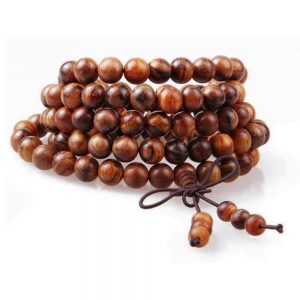The Sandalwood tree is known for its fragrant aroma as well as the beautiful wood it produces. The oil contains a lovely fragrance commonly used in incense, soaps, colognes and even cosmetics. In India, it is also used for medical purposes.
Grown mainly in India, Australia and Indonesia, the trees can grow as high as 25 to 30 feet tall. The evergreen thrives in poor, dry soil conditions and needs little water. The lifespan can reach 15 years when the maximum yield of oil and wood may be harvested. The bark is smooth and grayish-brown in color. The Indian government tightly regulates Sandalwood. Because of the high demand for religious, industrial and commercial purposes, it generates a lot of income for the government.
When the wood is ground into a powder it is commonly used in incense. When the incense is burned, a soothing woodsy aroma fills the air. Whether in powder form or oil, the scent is popular in aromatherapy, air fresheners and even health products.
Another dominant use of the tree is producing furniture and wood carvings. Sandalwood is sometimes considered the most expensive wood available in certain parts of the world. The wood is prized for its tightly dense grain, beauty and ability to maintain its fragrance for many, many years.
Besides furniture and artistic carvings, the wood is used to make Mala beads. A Mala bead necklace can be used for spiritual enlightening, meditation practice, prayer, religious ceremonies or simply worn as jewelry. Centuries ago, Sandalwood was burned at funerals with the belief that the scent would carry the soul to the next path of the universe.
Buddhists have used Sandalwood for hundreds of years. A strand of polished wooden beads, can speak to your soul, help clear the mind and open the heart to an abundance of love and good feelings. Sandalwood is believed to enhance and increase the power of your wishes leading to good fortune, deeper meditation, protection and success.
Buddhists also believe practicing with Sandalwood Mala beads increases their awareness, stimulates love, sensuality and deeper inner relaxation. Among the Chakras, the scent is geared towards the Base Chakra and promotes self-identity and inner trust. The aroma may build your enthusiasm for life and positivity. If you seek peace, passion and serenity, Sandalwood is a great choice for your meditation practice.
Among the traditional Buddhist Mala beads and Shamballa bracelets available at www.chopa.com, the Sandalwood mala necklace is one of the most popular sold. These Mala beads can be used to count mantras during meditation practice. One holds a bead between their thumb and forefinger and cites the mantra once per bead. Passing the beads through your fingers, allows you to focus on the mantra rather than counting the beads.
These Japa Mala contain 108 finely polished and aromatic Sandalwood beads. These natural 8mm beads are hand strung on a stretchy cord, finished with a guru bead and tied in an endless knot symbolizing wisdom and compassion for life. Two dangling tassels compliment the necklace and enhance the look when worn as a necklace. A free mala bag is included with every purchase to store and protect your beads when not in use.
Chopa Zen Home was established in 1994 and focuses on Zen Inspired Living. Whether browsing their wide selection of Japanese Kimono and yukata or perusing their offerings of Buddhist Mala beads and Shamballa bracelets you are sure to find something meaningful to enhance your life. Kimono and Yukata robes are perfect for loungewear and to wear around the house, to relax, cover up after a refreshing shower or to wear during a meditation session. The symbolism found in these gorgeous Japanese robes will inspire you to become your best. Don’t forget to add a Sandalwood Mala bead necklace to your shopping cart. Priced at just $14.00, they are affordable and beautiful to wear. Use as an accessory or let it help you focus and grow your own spiritual and mediation practice. Namaste.






